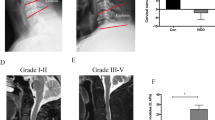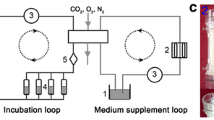Abstract
Background
Un-physiological loads play an important role in the degenerative process of inter-vertebral discs (IVD). In this study, we used an in vitro and in vivo rat model to investigate the mechanism of nucleus pulposus (NP) cells apoptosis induced by mechanical stress.
Methods
Static compressive load to IVDs of rat tails was used as the in vivo model. For the in vitro model, NP cells were tested under the physiological and un-physiological loading. For histological examination, apoptotic index study, and apoptotic gene expression, we also selected cytokines [bone morphogenetic protein (BMP)-2/7, insulin-like growth factor (IGF)-1, platelet-derived growth factor (PDGF)] to be analyzed.
Results
Under mechanical loading, cellular density was significantly decreased, but there was an increase of TUNEL positive cells and apoptosis index. In a dose-dependent manner; the necrosis became apparent in the un-physiologic strain. The selected cytokines (BMP-2/7, IGF-1, PDGF) can significantly reduce the percentage of apoptotic and necrotic cells.
Conclusions
We conclude that the intrinsic (mitochondrial) apoptotic pathway plays an important role in the compressive load-induced apoptosis of NP cells. Combination therapy reducing the mechanical load and selected cytokines (BMP-2/7, IGF-1 and PDGF) may have considerable promise in the treatment of spine disc degeneration.






Similar content being viewed by others
References
Thompson JP, Pearce RH, Schechter MT, Adams ME, Tsang IK, Bishop PB. Preliminary evaluation of a scheme for grading the gross morphology of the human intervertebral disc. Spine. 1990;15:411–5.
Horner HA, Urban JP. 2001 Volvo Award Winner in Basic Science Studies: efect of nutrient supply on the viability of cells from the nucleus pulposus of the intervertebral disc. Spine. 2001;26:2543–9.
Videman T, Sarna S, Battie MC, Koskinen S, Gill K, Paananen H, Gibbons L. The long-term effects of physical loading and exercise life styles on back-related symptoms, disability, and spinal pathology among men. Spine. 1995;20:699–709.
Battie MC, Videman T, Gill K, Moneta GB, Nyman R, Kaprio J, Koskenvuo M. 1991 Volvo Award in clinical sciences. Smoking and lumbar intervertebral disc degeneration: an MRI study of identical twins. Spine. 1991;16:1015–21.
Pratsinis H, Kletsas D. PDGF, bFGF and IGF-I stimulate the proliferation of intervertebral disc cells in vitro via the activation of the ERK and Akt signaling pathways. Eur Spine J. 2007;16:1858–66.
Kim JS, Ellman MB, An HS, van Wijnen AJ, Borgia JA, Im HJ. Insulin-like growth factor 1 synergizes with bone morphogenetic protein 7-mediated anabolism in bovine intervertebral disc cells. Arthritis Rheum. 2010;62:3706–15.
Leckie SK, Bechara BP, Hartman RA, Sowa GA, Woods BI, Coelho JP, Witt WT, Dong QD, Bowman BW, Bell KM, Vo NV, Wang B, Kang JD. Injection of AAV2-BMP2 and AAV2-TIMP1 into the nucleus pulposus slows the course of intervertebral disc degeneration in an in vivo rabbit model. Spine J. 2012;12:7–20.
Chaffin DB, Andersson GBJ. Occupational biomechanics. New York: Wiley; 1991.
Panjabi M, Goel V, Oxland T, Takata K, Duranceau J, Krag M, Price M. Human lumbar vertebrae: quantitative three-dimensional anatomy. Spine. 1992;17:299–306.
Tsuang YH, Lin YS, Chen LT, Cheng CK, Sun JS. Effect of dynamic compression on in vitro chondrocyte metabolism. Int J Artif Organs. 2008;31(5):439–49.
Imai Y, Miyamoto K, An HS, Thonar EJ, Andersson GB, Masuda K. Recombinant human osteogenic protein-1 upregulates proteoglycan metabolism of human annulus fibrosus and nucleus pulposus cells. Spine. 2007;32(12):1303–9.
Gruber HE, Hanley EN Jr. Analysis of aging and degeneration of the human intervertebral disc. Comparison of surgical specimens with normal controls. Spine. 1998;23:751–7.
Sato K, Kikuchi S, Yonezawa T. In vivo intradiscal pressure measurement in healthy individuals and in patients with ongoing back problems. Spine. 1999;24(23):2468–74.
Cromwell R, Schultz A, Beck R, Warwick D. Loads on the lumbar trunk during level walking. J Orthop Res. 1989;7:371–7.
Alini M, Eisenstein SM, Ito K, Little C, Kettler AA, Masuda K, Meltrose J, Ralphs J, Stokes I, Wilke HJ. Are animal models useful for studying human disc disorders/degeneration? Eur Spine J. 2008;17:2–19.
Pritzker KPH. Animal models for osteoarthritis: process, problems and prospects. Ann Rheum Dis. 1994;53:406–20.
Hickey DS, Hukins DWL. Aging changes in the macromolecular organization of the intervertebral disc. Spine. 1982;7:234–42.
Miyamoto S, Yonenobu K, Ono K. Experimental cervical spondylosis in the mouse. Spine. 1991;16:S495–500.
Lotz JC, Chin JR. Intervertebral disc cell death is dependent on the magnitude and duration of spinal loading. Spine. 2000;25:1477–83.
Park CO. Diurnal variation in lumbar MRI. Correlation between signal intensity, disc height, and disc bulge. Yonsei Med J. 1997;38(1):8–18.
Zhao CQ, Jiang LS, Dai LY. Programmed cell death in intervertebral disc degeneration. Apoptosis. 2006;11:2079–88.
Heyde CE, Tschoeke SK, Hellmuth M, Hostmann A, Ertel W, Oberholzer A. Trauma induces apoptosis in human thoracolumbar intervertebral disc. BMC Clin Pathol. 2006;6:5.
Gruber HE, Norton HJ, Hanley EN Jr. Anti-apoptotic effects of IGF-1 and PDGF on human intervertebral disc cells in vitro. Spine. 2000;25(17):2153–7.
An HS, Takegami K, Kamada H, Nguyen CM, Thonar EJ, Singh K, Andersson GB, Masuda K. Intradiscal administration of osteogenic protein-1 increases intervertebral disc height and proteoglycan content in the nucleus pulposus in normal adolescent rabbits. Spine (Phila Pa 1976). 2005;30(1):25–31.
Green DR, Ferguson TA. The role of Fas ligand in immune privilege. Nat Rev Mol Cell Biol. 2001;2(12):917–24.
Kim KW, Kim YS, Ha KY, Woo YK, Park JB, Park WS, An HS. An autocrine or paracrine Fas-mediated counterattack: a potential mechanism for apoptosis of notochordal cells in intact rat nucleus pulposus. Spine. 2005;30(11):1247–51.
Wang J, Tang T, Yang H, Yao X, Chen L, Liu W, Li T. The expression of Fas ligand on normal and stabbed-disc cells in a rabbit model of intervertebral disc degeneration: a possible pathogenesis. J Neurosurg Spine. 2007;6(5):425–30.
Tschoeke SK, Hellmuth M, Hostmann A, Robinson Y, Ertel W, Oberholzer A, Heyde CE. Apoptosis of human intervertebral discs after trauma compares to degenerated discs involving both receptor-mediated and mitochondrial-dependent pathways. J Orthop Res. 2008;26(7):999–1006.
Rannou F, Lee TS, Zhou RH, Chin J, Lotz JC, Mayoux-Benhamou MA, Barbet JP, Chevrot A, Shyy JY. Intervertebral disc degeneration: the role of the mitochondrial pathway in annulus fibrosus cell apoptosis induced by overload. Am J Pathol. 2004;164:915–24.
Ding F, Shao ZW, Yang SH, Wu Q, Gao F, Xiong LM. Role of mitochondrial pathway in compression-induced apoptosis of nucleus pulposus cells. Apoptosis. 2012;17(6):579–90.
Anderson DG, Tannoury C. Molecular pathogenic factors in symptomatic disc degeneration. Spine J. 2005;5:260–6.
Pachori AS, Custer L, Hansen D, Clapp S, Kemppa E, Klingensmith J. Bone morphogenetic protein 4 mediates myocardial ischemic injury through JNK-dependent signaling pathway. J Mol Cell Cardiol. 2010;48(6):1255–65.
Yang J, Liu X, Nyland SB, Zhang R, Ryland LK, Broeg K, Baab KT, Jarbadan NR, Irby R, Loughran TP Jr. Platelet-derived growth factor mediates survival of leukemic large granular lymphocytes via an autocrine regulatory pathway. Blood. 2010;115(1):51–60.
Yang SY, Hoy M, Fuller B, Sales KM, Seifalian AM, Winslet MC. Pretreatment with insulin-like growth factor I protects skeletal muscle cells against oxidative damage via PI3K/Akt and ERK1/2 MAPK pathways. Lab Investig. 2010;90(3):391–401.
Acknowledgments
The authors wish to acknowledge The National Science Council, Taiwan, ROC and Research Fund of Hsin-Chu General Hospital, Department of Health, Executive Yuan, Taiwan, ROC for their funding assistance for this work. We also thank Ms. Margaret, ManGer Sun for her help and valuable suggestions.
Conflict of interest
The authors declare that they have no conflict of interest.
Author information
Authors and Affiliations
Corresponding authors
Electronic supplementary material
Below is the link to the electronic supplementary material.
776_2013_510_MOESM1_ESM.tif
Fig. S Histological and Immuno-histochemical TUNEL stain evaluation of stab injury and static compression-loading on the inter-vertebral disc. Upper row: In the normal inter-vertebral disc of the control sample, the gelatinous nucleus pulposus contains a cellular interior with proteoglycan around the perimeter, sometimes with a capsule around them. At the time point of 1 day after stab injury, there were degenerative changes at the disc tissue. At the time point of 3 days after stab injury, the stab-injured discs showed significant sparse cellular density, clusters of nucleus pulposus cells and abundant extracellular matrix expression. Normal morphology was observed in the majority of discs loaded with 6.4N-1day which was similar to the control group. In the 6.4N-3 day group, there were structural changes in the nucleus, consisting of increased extracellular matrix and a decreased area of the cellular region. Similar changes were observed in the 20.8N-1day’s disc. The changes were more pronounced as significant decreased cellular density, increased extracellular matrix expression and clusters of nucleus pulposus cells were noted in the 20.8N-3days’ discs. Lower Row: In this study, no matter the compressive load or what were the stabbing-injured discs, they showed a significant increase of TUNEL positive cells, indicating evident apoptosis in comparison to the control group in a dose dependent pattern (TIFF 923 kb)
About this article
Cite this article
Kuo, YJ., Wu, LC., Sun, JS. et al. Mechanical stress-induced apoptosis of nucleus pulposus cells: an in vitro and in vivo rat model. J Orthop Sci 19, 313–322 (2014). https://doi.org/10.1007/s00776-013-0510-2
Received:
Accepted:
Published:
Issue Date:
DOI: https://doi.org/10.1007/s00776-013-0510-2




